Evidence of the Effectiveness of the SSEP Online Course
“Before-and-After” comparisons of OASES data submitted by students between November 2020 and November 2023
The “Overall Assessment of the Speaker’s Experience of Stuttering” (OASES™) self- assessment tool was originally developed at Michigan State University by Professors Scott Yaruss & Robert Quesal. It provides a comprehensive assessment of the stuttering disorder from the speaker’s perspective. It gives clinicians and researchers meaningful insights into the client’s experiences that can be used in the diagnostic process, for treatment planning, and in outcomes assessment.
Further details of this assessment can be found via the following two links..
Assessing quality of life in stuttering treatment outcomes research
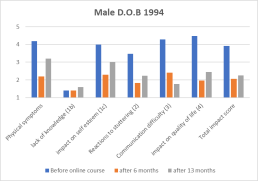
Male D.O.B 1994. This student has previously had speech therapy and done the McGuire and Barbara Dahm courses. Currently also having hypnotherapy. Has a history of remission then relapse following therapy.
“It really was eye-opening completing this questionnaire. I’ve almost forgotten how bad it was… I was especially surprised with the Quality of Life section. Stuttering was really destroying my quality of life back then.
Now, my perceptions of myself are still quite negative. But other areas, like how much stuttering interferes with my ability to be successful, or to do normal day to day things like using the telephone, talk to my girlfriend, strangers etc… it doesn’t interfere with that at all! In fact, I can use the phone pretty much fine, order food, do public speaking… I even played ‘Articulate’ properly twice recently, which was a massive massive fear of mine (I was traumatised so bad 10+ years ago where I literally left the room to avoid playing. This time I just didn’t think and tried to speak as fast as possible).
So yeah… very interesting. It suggests that stuttering doesn’t really have any negative impact on my life from an objective viewpoint, and it most certainly doesn’t stop me generally from talking to people! But my internal perception is still very negative and I feel anxious a lot. Mainly about the prospect of relapse and ‘it coming back’ or the jump/hypnotherapy ‘not working anymore’”.
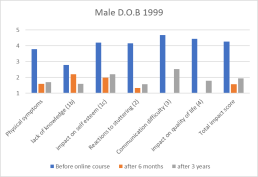
Male D.O.B 1999 This student has also done the Lee Lovatt course and read “Speech is a River” by Ruth Mead, and “redefining stuttering” by John Harrison.
“My speech has been holding up great! I still have moments where I can feel a block coming on every once in a blue moon, but the jump has never failed me yet. It truly feels to me like the foolproof solution I spent a decade of my life looking for and thought I’d never find.
And I noticed that giving excessive priority to accuracy over fluency is a problem I have in all aspects of my life. Everything from the way I do my accounting work to the way I do basic things like showering lol. So everything I do takes far longer than it should. Changing this is now a much bigger focus than my speech.”
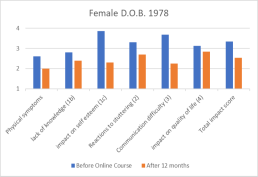
Female D.O.B. 1978
“After filling the questions before I started the course, I realized I can improve my speech in many situations and work on my ingrained fears. Some of my limitations didn’t apply to stuttering. I could see myself improving the quality of my life, my communication within family and with friends and improving my ability to progress in career with consistent effort.
Initially I was working hard but was not consistent. So I was not getting results. I was inspired by my self-help group to be consistent in my speech practice and now it’s showing the results. I practice reading aloud with the techniques on my terrace, also meditation, abdominal breathing, carnatic singing practice, now starting talking with strangers…I can feel the change.”
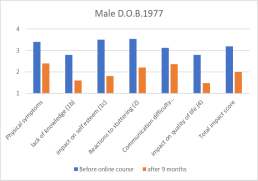
Male D.O.B.1977 This student has also done the Starfish course.
“The course has been brilliant. I have been using it together with the Starfish technique and mindfulness and non-avoidance. The mindfulness and beliefs sections have been very helpful. The main challenge I found with the Jump is trying to reduce the time between sounds. I find the jump is very good to reduce avoidance and to keep moving forward, although when I’m tense I find it harder to use. Sometimes people don’t understand you and you need to be focused to use a different technique in order to be understood”.
“Thank you for the advice on putting less effort into using the jump, similar to walking. That has made a big difference. I was using force with the jump rather than moving onto the next sound in a relaxed way. I still need to work on maintaining eye contact and looking away, but I am doing better.
I found Orchestral Speech the most helpful when I imagine the words in my head which are moving forward. I sometimes struggle to get a rhythm and not sure sometimes what beat or rhythm to use. But the words highlighted in your head helps. It is hard when my jaw is tense as I sometimes have secondary symptoms where I pull my mouth sideways. Also I need to remind myself to use the Jump as the main technique to help non avoidance. It’s great to see how its moving in the right direction. I am finding using the jump in a relaxed way very helpful.
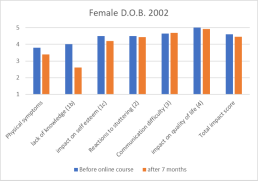
Female Student D.O.B. 2002
I think it’s a really good course but I didn’t make use of it properly. I am always Iike this when I find a new technique or website or book I get really excited and say okay when I do these things I’ll be normal and I’ll never stutter again, then I try them for a week or two and see it doesn’t really completely get rid of my stuttering but I hate failure so I just postpone it and say someday I’ll read these more carefully do all the exercises and get rid of my stuttering. I just postpone it over and over again because I’m scared.
When I started using the jump I felt like just knowing this new technique made me stutter less but for the last month or so my stuttering has gotten really bad and when I try to do the jump or any other technique I just can’t for some reason it was easier at first but I don’t really know what happened.
As i said for the jump, when i first learned orchestral speech it helped me out a lot for like 1-2 weeks but then i stopped using it, also as i said my stuttering has gotten a lot worse for the last month.
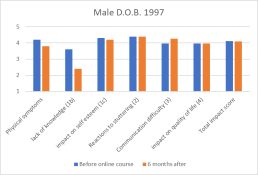
Male Student D.O.B. 1997
Found the Understanding Stammering module easy to understand and helpful. Was unable to employ Orchestral speech. Some success using the Jump, but was unable to instil the habit of using it.
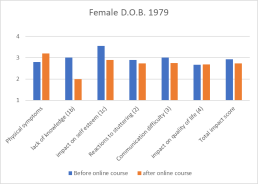
Female D.O.B. 1979
“Since taking the course… I am more aware of my stammer than I used to be, but that awareness is heading in a more positive direction, if that makes sense? I may stammer more at the moment, but I feel like that is because I am saying what I want more than I used to, so inside I feel more settled.
The course was full of information & I think I was interested in it first for the speech techniques, but they ended up being the least interesting to me. Understanding stammering really did help me to accept my stammer &, more importantly, myself a little bit more.”
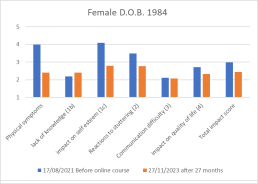
Female D.O.B. 1984. Stammering onset at 11 years old. Family history of stammering. This student had NHS therapy (in 2009) and also took a City Lit course on Interiorized stammering (in 2022- after the online course)
Follow-up March2022 (no OASES data): I appreciated all the theory and reasons for stuttering. One thing which resonated with me is that people with a stammer are prone to more speech trips than people without. I definitely think that is true for me because there are times when I am clear in what I want to say – no blocking – but it comes out a little jumbled. With the jump I have found that I can’t move forwards over, it’s like I get stuck in that moment.
Follow-up Nov 2023: Although I have seen a big reduction in negative feelings … ultimately I wish I didn’t speak this way and it does impact my confidence at work.